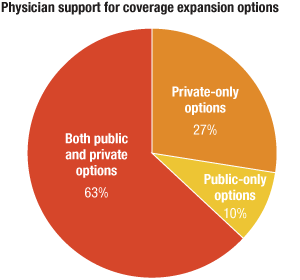 The survey was designed and conducted by Drs. Salomeh Keyhani and Alex Federman of Mount Sinai School of Medicine. Over the summer of 2009, they surveyed a random sample of more than 2,000 physicians. (Alyson Hurt/NPR)
The survey was designed and conducted by Drs. Salomeh Keyhani and Alex Federman of Mount Sinai School of Medicine. Over the summer of 2009, they surveyed a random sample of more than 2,000 physicians. (Alyson Hurt/NPR)
Among all the players in the health care debate, doctors may be the least understood about where they stand on some of the key issues around changing the health care system. Now, a new survey finds some surprising results: A large majority of doctors say there should be a public option.
When polled, “nearly three-quarters of physicians supported some form of a public option, either alone or in combination with private insurance options,” says Dr. Salomeh Keyhani. She and Dr. Alex Federman, both internists and researchers at Mount Sinai School of Medicine in New York, conducted a random survey, by mail and by phone, of 2,130 doctors. They surveyed them from June right up to early September.
Related Audio
Most doctors – 63 percent – say they favor giving patients a choice that would include both public and private insurance. That’s the position of President Obama and of many congressional Democrats. In addition, another 10 percent of doctors say they favor a public option only; they’d like to see a single-payer health care system. Together, the two groups add up to 73 percent.
When the American public is polled, anywhere from 50 to 70 percent favor a public option. So that means that when compared to their patients, doctors are bigger supporters of a public option.
Doctors’ Support For Public Option ‘Broad And Widespread’
The researchers say they found strong support for a public option among all categories of doctors. “We even saw that support being the same whether physicians lived in rural areas or metropolitan areas,” says Federman.
“Whether they lived in southern regions of the United States or traditionally liberal parts of the country,” says Keyhani, “we found that physicians, regardless – whether they were salaried or they were practice owners, regardless of whether they were specialists or primary care providers, regardless of where they lived – the support for the public option was broad and widespread.”
Keyhani says doctors already have experience with government-run health care, with Medicare. And she says the survey shows that, overall, they like it. “We’ve heard a lot about how the government is standing in between patients and their physician,” Keyhani says. “And what we can see is that physicians support Medicare. So I think physicians have sort of signaled that a public option that’s similar in design to Medicare would be a good way of ensuring patients get the care that they need.”
The survey was published online Monday by the New England Journal of Medicine. It was funded by the Robert Wood Johnson Foundation, a health care research organization that favors health reform.
AMA Doctors Also Support Public Option
The survey even found widespread support for a public option among doctors who are members of the American Medical Association, a group that’s opposed to it. The AMA fears a public option eventually could lead to government putting more limits on doctors’ fees.
“The American Medical Association has traditionally been probably the loudest voice for physicians across the United States,” says Federman. “And part of our reason for doing this research was really to get at the real voice of physicians as opposed to the voice of one physician organization.”
Keyhani and Federman belong to another, smaller group, the National Physicians Alliance. It supports a public option, and Keyhani has spoken publicly about her own support for a public option.
What Would A Public Option Look Like?
It’s hard to know for sure what doctors mean when they speak about a public option, says Dr. James Rohack, president of the AMA.
“Because when I say public option, or you say public option, it means different things to different people, kind of like the Rorschach ink blot test – when you look at it, to some people it means one thing, to other people it means the other thing.”
Politicians in Washington turn to the AMA for support and guidance, even though fewer than a third of practicing doctors belong to the lobbying group.
The AMA’s own position on a health overhaul has, at times, been hard to pinpoint. In July, it praised the bill that came out of the House of Representatives. That bill included a public option. But the AMA made it clear that what it really liked was that it eliminated cuts in doctors’ fees from Medicare.
“And so I think that’s why we need to be very clear about what does the AMA articulate for,” says Rohack. “It’s to make sure that everyone has coverage that’s affordable, that’s portable and that is quality – that is, it covers the things you need to cover because you’ve got a medical condition or developed a medical illness.”






